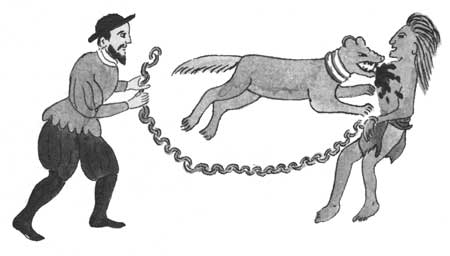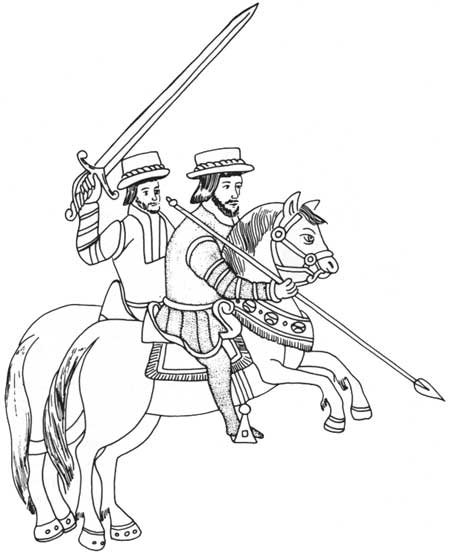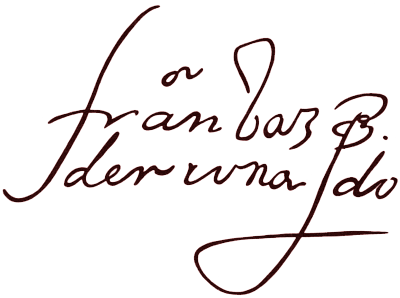

Contents Foreword Preface The Invaders 1540-1542 The New Mexico: Preliminaries to Conquest 1542-1595 Oñate's Disenchantment 1595-1617 The "Christianization" of Pecos 1617-1659 The Shadow of the Inquisition 1659-1680 Their Own Worst Enemies 1680-1704 Pecos and the Friars 1704-1794 Pecos, the Plains, and the Provincias Internas 1704-1794 Toward Extinction 1794-1840 Epilogue Abbreviations Notes Bibliography |
El Turco's Tales of Quivira El Turco, it seemed, under Father Padilla's withering questioning, had indicated by signs and a smattering of Nahuatl that Quivira, some days to the northeast, abounded in gold, silver, and rich textiles. This at last must be the Seven Cities. Furthermore, alleged El Turco, Bigotes of Cicuye could confirm it. Bigotes had in his possession a golden bracelet that had belonged to El Turco. Back at Cicuye, the anxious Alvarado confronted Bigotes and the elderly headman the Spaniards called Cacique. They denied that any such precious bracelet ever existed. When the two natives refused to go with him to see Coronado, the Spanish captain succeeded in getting them to his tent. There he had them put in collars and chains along with El Turco. That was too much for the people of the pueblo. "They came out to do battle, shooting arrows and reviling Hernando de Alvarado, saying that he was a man who broke his word and betrayed their friendship." Either they feared for the lives of the hostages and were trying only to bluff the invaders, or the pueblo with "as many as five hundred warriors" was badly divided, for the men of Cicuye inflicted no casualties. The events of the next few days are jumbled in the accounts of the expedition. El Turco "escaped" twice. Both times Álvarado let Bigotes and Cacique go to retrieve him. Then, while relations between Spaniards and Cicuye seemed badly strained, the Spanish captain and his men purportedly joined forces with three hundred of the pueblo's warriors for a campaign against a people called Nanapagua. A few days later, the campaign was dropped and the Spaniards withdrew to rejoin Coronado, taking with them Cacique, Bigotes, El Turco, and Sopete collared and chained. [17] The first meeting of the invaders and Cicuye had ended in bad faith. Álvarado Takes Captives to Tiguex Snow had already fallen when Hernando de Alvarado reached the Tiguex pueblos with his prisoners. There he found García López de Cárdenas and an advanced detail setting up camp for the entire army. The invaders would winter among the Southern Tiwas as Álvarado and Fray Juan de Padilla had suggested, an experience none of them would ever forget. The night after Coronado arrived, Captain Álvarado reported to him with El Turco in tow. The Indian captive cooperated fully. What he related delighted the general. Across the plains to the east, he gestured,
Visions of Riches to the East El Turco was probably describing the Mississippi where some rulers did indeed travel in ornate ceremonial barges and the garfish grew as long as horses. Father Padilla could see it all, and more. This heathen plainly had glimpsed the marvels of Antillia. To Coronado and his wearied adventurers, lodged in earth houses, El Turco's mirage must have sounded like another Mexico. But before they could see it themselves, they had to endure the pains of winter and a war against the people of Tiguex. The invaders had simply taken over one entire pueblo, just above present-day Bernalillo. The natives had moved out grudgingly, seeking in other pueblos shelter from the biting cold. At first the Spaniards traded petty merchandise for blankets, turkeys, and maize, as the viceroy had ordered; then in dire need they resorted to forced levies. A soldier raped an Indian woman. Trying to get at the truth of the golden bracelet, someone sicced a dog on Bigotes. Even so, neither Captain Álvarado nor Father Padilla could shake the Indian's plea that El Turco was lying. The rankled Tiwas began by stealing and killing Spanish horses. When Coronado sent captains to reprimand them, they holed up in their pueblos and shouted abuse. The invaders had no choice. They could not hope to set out for the golden land to the east with defiant Indians at their rear. Therefore the general, with the necessary if reluctant consent of the friars, resolved to wage the kind of war spelled out in the requerimiento. If the Indians refused to submit, he would show them no quarter. They refused.
The Sieges of Arenal and Moho The first assault aborted. Inside the pueblo, called Arenal by the Spaniards, the defenders held out. Not until the attackers knocked holes in the walls and lighted smudge fires did the battle turn. Then as the choking Tiwas poured out, the Spaniards cut them down or burned them at the stake. As an object lesson, Cacique and Bigotes, leaders from the powerful Cicuye, along with El Turco and Sopete, were made to watch the Tiwas burn. The extreme penalty inflicted upon Arenal did not end the war. Fortifying several other pueblos, the unyielding Indians forced the Spaniards to maintain long winter sieges. As attack after attack failed, months passed. From early January to late March 1541, the defenders of a pueblo called Moho repulsed every onslaught and every appeal to surrender. When finally thirst forced them to flee one night in the dark, the invaders on horseback rode them down or took them captive. Another pueblo fell and was sacked. Dozens of Tiwa women and children found themselves slaves in the camp of the Spaniards, just as the requerimiento had warned. [19] The Pueblos Divided Coronado's rude thrust into the heartland of the pueblos upset the prevailing balance of power. While besieged Southern Tiwas fought for their lives, the Keres pueblo of Zia provided the invaders with blankets and food stuffs and an offer of alliance. The Tiwas appealed to Cicuye, a pueblo with reason enough of its own to oppose the Spaniards. If the eastern stronghold did send aid, it went unrecorded. On the contrary, claimed Coronado, the captives Cacique and Bigotes told him that Cicuye and the Tiwas were enemies. If the Spaniards would give them one of the Tiwa pueblos as spoils to settle and farm, the men of Cicuye would "come and help him in the war." Whether or not the two Indians really made that offer, and whatever their intent, Coronado knew that he must make his peace with their pueblo, the gateway to the east.
By all accounts, Cicuye was a power to be reckoned with. "Feared throughout that land," the eastern pueblo, because of its very location, had to maintain relations with people of both plains and pueblos. About l525, according to Pedro de Castañeda, the fierce Teyas had tried to conquer Cicuye. This plains people, likely Caddoan-speaking ancestors or relatives of the Wichita Indians, allegedly had destroyed some pueblos in the Galisteo Basin so thoroughly that Castañeda thought the attackers must have used war machines. They had assaulted Cicuye but failed to carry it. Now, in 1541, the Teyas were at peace with the Pueblos. "Although they receive them as friends and trade with them, at night the visitors do not stay in the pueblos but outside under the eaves." [20] Evidently the strength Cicuye had shown against the Teyas had brought the Tano pueblos of the Galisteo Basin under her sway. "There are along this road," wrote Castañeda, "toward the snowy mountains seven pueblos—one of them half destroyed by the above-mentioned people—which are under obedience to Cicuye." Coronado Seeks Aid of Cicuye Sometime during the course of the Tiguex war, Coronado resolved to go in person to cement an alliance with Cicuye. To show his good will, he released Cacique and escorted him home. Bigotes, "ill disposed and somewhat dishonest in his conduct," he refused to return just yet. Approaching the tiered gray-brown citadel, the personal emissary of the emperor's viceroy must have awed the natives in his suit of golden armor and his plumed helmet from which the dents of Zuñi had been hammered out. This was an occasion of state.
En Route to Quivira In late April or early May 1541, the residents of Cicuye looked out to see Coronado's entire army encamped in the valley below: more than fifteen hundred persons counting Mexican Indian allies and Tiwa slaves, likely an exaggeration, with hundreds of horses, cattle, and sheep. Behind them the pueblos of Tiguex lay deserted. The general, against the counsel of some of his officers, had committed his whole force to the discovery of Quivira. As incentive, El Turco had embellished his description to the point "that had it been true, it would have to have been the richest thing in the Indies." [22] Cicuye now "rejoiced" at the restoration of Bigotes and the thought of the invaders' imminent departure for the plains. The inhabitants shared their provisions. Cacique and Bigotes gave Coronado another Quivira guide, a young lad named Xabe, who like Sopete agreed that gold and silver were to be found in his land but not in the abundance El Turco had implied. "The army set out from Cicuye," observed Castañeda, "leaving the pueblo at peace and to all appearances content and bound to maintain friendship because their governor and captain had been restored to them." Later, hundreds of miles to the northeast, El Turco would implicate Cicuye in a plot to destroy the invaders. [23]
Much as the Pueblo Indians might have wished it, the plains did not swallow up the Spaniards. Four days out the army built a bridge not far from today's Conchas Lake and crossed over the Canadian River. [24] Led on by El Turco, they came upon the buffalo, so numerous, said Coronado, that "there was not a single day until my return that I lost sight of them." They met and marveled at the Apaches called Querechos, with their portable skin tipis and dog travois, following the great dark herds. Some days southeast over the hauntingly flat Llano Estacado, the Spanish caravan encountered the people called Teyas. Although these tattooed and painted natives closely resembled the Querechos in appearance and style of life, at least while on the hunt, the two groups were enemies. The Teyas led the Spaniards down into a deep gorge. What they conveyed to Coronado, the abrupt change in terrain, and the expedition's southerly instead of northeasterly route finally convinced the general that El Turco was purposely leading them astray. Ordering the bulk of the army back to Tiguex, Coronado with thirty of his best mounted men, a dozen or so servants and the pigheaded Fray Juan de Padilla struck north "by the needle" for Quivira about June 1, 1541. Sopete led the way. El Turco followed in chains. The Murder of El Turco By mid-summer the invaders beheld Quivira. They were in present-day Kansas, centuries before the first plow. The countryside appeared gloriously rich and verdant. The rivers and streams ran clear. But instead of the alabaster walls of Antillia or even a tree hung with golden bells that played in the breeze, there were only scattered settlements of grass lodges and one old chief with a copper ornament. The people of Quivira were the semisedentary Wichitas living along the great bend of the Arkansas River. [25] Several weeks of exploration failed to turn up anything but stories of wonders farther on. A council of officers agreed with the general: they should turn back to Tiguex and next year marshal a larger force to explore beyond Quivira. Nothing could shake Father Padilla's belief that the Seven Cities rose farther east, ever farther. El Turco had become a liability. Because of his alleged scheming with the natives of Quivira, the Spaniards decided to eliminate him. Under interrogation he laid bare the plot of Cicuye as well. Why, the Spaniards demanded, had he lied and so maliciously misguided them? He answered
Melchior Pérez, one of Cicuye's discoverers, "from behind put a rope around El Turco's neck, twisted it with a garrote, and choked him to death." [27] Burying the body at night, the Spaniards broke camp in haste and rode west by a more direct route to rejoin the army at Tiguex. Coronado feared what Cicuye might already have done. | ||||||
 Top Top
|
| ||||||





